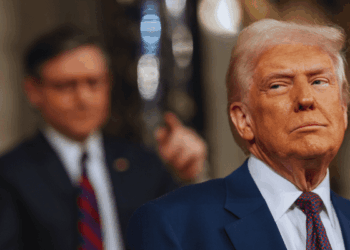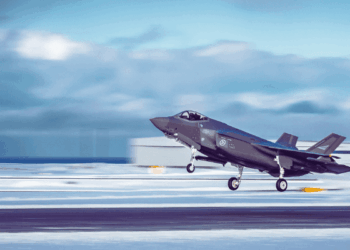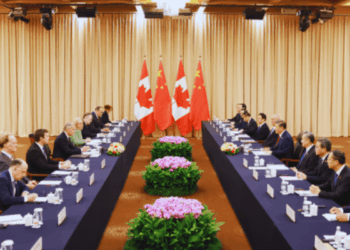This article originally appeared in The Diplomat.
By Joe Varner, September 5, 2025
China’s latest military parade , which took place in Beijing on September 3, was never simply a commemoration of wartime sacrifice against Japan and the Axis powers. It was a carefully choreographed show of force directed at Washington, America’s Asian allies, and India, as well as Chinese audiences at home and abroad.
With Chinese President Xi Jinping flanked by Russian President Vladimir Putin and North Korean leader Kim Jong Un, the optics were blunt: China intends to be treated as a global military peer, to set the foundations of a new world order, and it wants the Western world to take note.
The parade’s centrepiece was the public unveiling of China’s maturing nuclear triad. New intercontinental ballistic missiles – the DF-61 and DF-31BJ – rolled down Chang’an Avenue alongside the JL-3 submarine-launched ballistic missile and the smaller air-launched JL-1. This sent the message that China can now credibly claim a land, sea, and air second-strike capability. For the United States, the surprise appearance of the DF-61 – unknown until this event – raises questions about what else Beijing is holding back and complicates strategic planning. Washington must now assume that China’s deterrent is more survivable and diverse than previously acknowledged.
At the regional level, the display was dominated by hypersonic weapons. Variants of the DF-26 intermediate-range missile, already nicknamed the “Guam killer,” were joined by a family of anti-ship systems, from the ramjet-powered YJ-15, to the hypersonic YJ-17, YJ-19, YJ-20, and YJ-21. The DF-17, carrying a maneuverable hypersonic glide vehicle, rounded out the picture.
These weapons are designed to target U.S. carrier strike groups, regional bases, and allied fleets across the western Pacific. What this means for U.S. allies such as Japan, South Korea, and Australia is that the cost of intervention in any Taiwan or South China Sea contingency has gone up, and warning times have gone down.
The People’s Liberation Army also showcased its ambitions in new domains. The formal inclusion in the parade of aerospace, cyberspace, and information support forces highlights a structural shift toward future conflict where space, cyber, and AI-enabled “intelligentized” warfare will be decisive. The debut of the HQ-29 ballistic missile interceptor – China’s answer to America’s SM-3 – suggests Beijing is preparing to contest not only ballistic missiles but also satellites in low Earth orbit. If fielded in numbers, that would mark a significant shift in the regional balance of power, undermining U.S. missile defence and space-based command networks.
For Taiwan, the show was a reminder of the pressure it lives under daily. Precision rocket artillery, stealth drones like the GJ-11, and unmanned surface and undersea systems point toward a campaign of rapid saturation strikes and sea denial rather than a guaranteed amphibious assault. None of these systems guarantee victory, but together they complicate Taipei’s mobilization and narrow the window for outside reinforcement. In the South China Sea, hypersonic anti-ship missiles and large unmanned undersea vehicles communicate to Southeast Asian states that China can dominate the battlespace from the seabed to the upper atmosphere.
For domestic audiences and the overseas Chinese diaspora, the parade was packaged as a moment of pride and unity. Children in China had to watch the parade in schools. Unlike past parades, no foreign military troops took part in the event, even though world leaders like Putin and Kim were present. Xi’s rhetoric invoked history, national rejuvenation, and the inevitability of peaceful development, even as advanced nuclear missiles and hypersonic weapons rumbled past. The narrative was balanced between reassurance to the public, pride for the diaspora, and deterrence for the United States and its allies.
Are there genuine game-changers in the systems unveiled? A few stand out. The JL-3 SLBM significantly strengthens sea-based deterrence. The HQ-29 suggests an emerging Chinese anti-missile and anti-satellite capability. And the KJ-600 airborne early warning aircraft, paired with the new J-35 stealth fighter, could dramatically improve the effectiveness of China’s future carrier groups. Yet most of the equipment remains evolutionary. While these systems reinforce deterrence and impose costs, they do not overturn the military balance overnight.
In essence, Beijing’s parade was a form of “deterrence theatre.” It was designed to demonstrate that China has the tools to punish intervention, deny access, and survive escalation. For Washington, Tokyo, Seoul, Taipei, Manila, and Canberra, the balance for military power and deterrence has not flipped, though the price of maintaining it has risen. The U.S. and its allies are now on notice that any contest with China will be longer, harder, and riskier than ever before.
Joe Varner is a senior fellow at the Macdonald-Laurier Institute in Ottawa and the Center for North American Prosperity and Security in Washington, D.C.








